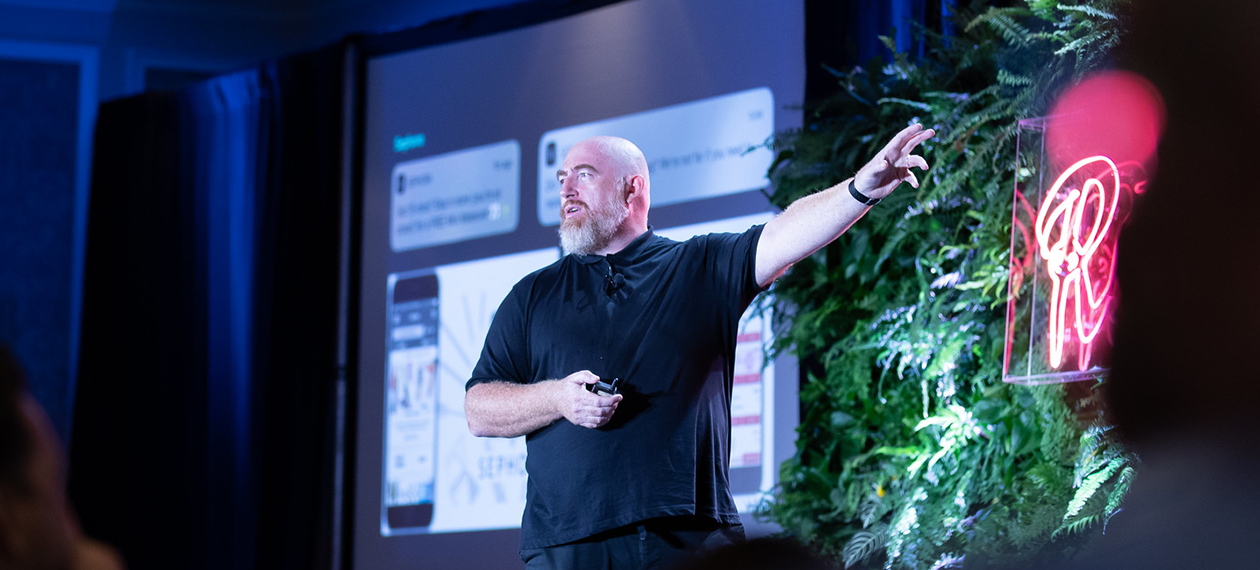Retailers scratching their heads over what customer-facing in-store technology to invest in may be able to save themselves some trouble.
After all, Alasdair Lennox explained during his talk at RetailSpaces, in an age when 60 percent of Gen Z consumers access the internet exclusively through their smartphones, why not just rely on them to bring the necessary hardware?
“They prefer to use their own device rather than in-store tech to interact with brands,” the Executive Creative Director at FITCH said, referring to research from IDG. He then posed a couple of questions for the audience of store development leaders: “How do we design a bricks-and-mortar store for a generation that’s always heads down? How do we get them to get heads up and engage in our store designs?”
Instead of resisting customers’ deepening relationship with smartphones, retailers need to embrace them, designing stores with mobile devices in mind so that they can leverage them as marketing tools, rather than barriers to sales.
Lennox highlighted examples of physical spaces around the world that come alive by targeting three universal shopper mind-states — locating, exploring, and dreaming — and incorporating mobile devices and digital tools.
Smartphones as a Navigational Aide
The "locating" mind-state means customers are searching for real-time information and "hacks" for the shopping experience. According to Retail Dive, nearly 60 percent of shoppers look up product information and prices while using their mobile phones in stores. The number one reason for this is that people are looking for competitive prices, coupons, and deals, and also searching for more information like referrals and reviews.
“How do we design a bricks-and-mortar store for a generation that’s always heads down?"
But that's not the only thing people are using their smartphones for in-store. According to Statista, 54 percent of respondents aged 18-29 said they use their phones for maps and/or GPS navigation in-store. In response to that, the Sam's Club Now app incorporates digital navigation and smart list shopping, so you can find exactly where a specific product is located in the store on the app and get directional navigation right to it, and track all of your items in "the smartest shopping list in retail."
The implication of this for retail stores today is that they need less high-level signage since shoppers no longer look up. There is also an extremely powerful opportunity in owning the shopping list and directing physical journeys inside the store that can introduce shoppers to new, unexpected products and experiences along the way.
Shoppers also use their smartphones as a voice-command remote control. Quoracreative found that by 2020, 50 percent of all searches across the Internet will be voice-based, utilizing things like smart home assistants and hands-free digital assistants.
Given this, stores need to be quieter to allow for voice engagement, and less printed material will be necessary to tell their stories. This also means that stores can start to become assisted-voice journeys, and have integrated "service centers" with human or bot assistants answering live questions.
"I think there's a massive opportunity around voice response in retail," Lennox said.
 Alasdair Lennox at RetailSpaces'19
Alasdair Lennox at RetailSpaces'19
Powering “Surrogate Shoppers”
A third reason people use their smartphones in-store — or, in this case, in lieu of going to a store — is because it acts as their "eyes" through a surrogate shopper. Lennox cited examples of a personal shopper at the Harvey Nichols luxury department store connecting to her customers at home through photos, videos, and live streaming broadcasts, as well as live streaming with influencers in-store at retailers in China.
"There is a clear trend here around consumers at home paying for a shopper to be in-store," said Lennox. "This allows customers access to a personal stylist on demand."
In some categories, he predicted, this will mean there will be fewer consumers in-store, but more professional shoppers. Stores will then become more like large-scale displays for "picking." This also allows consumers to buy things that are out of their physical reach or market.
"Surrogate shoppers can make proactive recommendations and become trusted advisors," said Lennox. "We really see an above-the-line shift towards influencer-led [marketing]. Once you get a trusted fashion influencer, they could become your biggest director of what products you buy in-store. Influencer retail is absolutely massive."
Eliminating the Queue
People also use their smartphones to "jump lines." At Nike, shoppers can scan a QR code on their phones, choose the product and size they want, request a fitting room, or have shoes delivered to them from the stock room with real-time updates.
The bottom line is, guests are no longer willing to wait in line at the fitting rooms or at the point of sale, and they're also not willing to wait for items to be delivered to them from the stockroom.
Freeing up this time previously spent waiting in line gives the shopper more time to do other things in-store. It creates new areas to suggest accessories or related products. "What do we do with all this positive time we're freeing up?" Lennox asked attendees. "We should be merchandising products in different ways around that."
Finally, people use their smartphones as their shopping baskets and wallets. According to research published by Worldpay in 2018, by 2022 the global use of mobile payments will increase to 28 percent and eventually surpass credit cards and cash.
At Alibaba's Hema grocery store in China, every item has a barcode. Shoppers download the app, scan an item's barcode to get information about it, and get recommendations based on other items they're buying.
Lennox said this will ultimately mean little to no POS staff as customers increasingly check themselves out, freeing up employees to engage more with customers on the floor and focus on stock and merchandising.

Alibaba's Hema grocery China
Enticing Exploration
"Exploring" refers to tools that help customers filter their choices and predict what they didn’t know they needed.
When customers are in an "exploring" mind-state, they use their smartphones as a way to help the retailer "read their mind" before they arrive. Beauty retailer Sephora uses push notifications when a customer is nearby to encourage them to stop in for a mini-makeover or replace must-have items.
Utilizing GPS-enabled push notifications in this way creates new, unplanned reasons to visit a store based on the customer's location and their need state. It also enables predictive ordering, which Lennox said will be a "massive future" for retail.
Push messaging can also "announce" a customer's arrival and their preferences to store staff, so customers will experience better and more personalized service immediately. In turn, shoppers will increasingly expect employees to know their likes and dislikes without being questioned and will look for a much more personalized experience. This will create a new dynamic between the staff and customers that builds loyalty through empathy.
Shoppers also use mobile apps to personalize their selections, such as with IKEA's augmented reality app that allows users to envision pieces of furniture in their homes. Lennox said that this means there will be a shift from merchandise density to studio creativity. In the future, this will mean more full immersive customization experiences like Nike's NYC House of Innovation 000 and the ultimate in bespoke, real-time manufacturing: in-store 3D printing.
Orchestrating the Physical and Digital Crossover
Thanks to smartphones, the world has become one big selfie backdrop, and the retailers who cater not just to the customer inside their store but also that customer's entire social network through Instagram-ready experiences (and strong, free, easy-to-access Wi-Fi) will be able to facilitate a much richer conversation with their customers and their networks.
The trick is, the brand has to instigate that "conversation;" it has to present its stores as stage sets complete with good lighting, backdrops, and props — like at Sony Square NYC — and it has to make it easy for customers to access their trusted network of friends and family (again: Wi-Fi). And, once again, influencer marketing will play a big role in this, too.
Smartphone users also enjoy being part of a brand's story rather than just observing it. According to research by Retail Perceptions, 61 percent of shoppers prefer to shop at stores that offer augmented reality. Adidas, for example, uses AR to release exclusive content to app users — quite a perk for the loyal mobile-first customer, considering the secondary sneaker market alone is estimated to be worth up to $1 billion.
The opportunity for retailers here is to drive new in-store traffic by offering exclusive top content and experiences in-store.
"The physical store design needs to be dramatically different than it is today."
With this "mobile first" mindset powered by $1,000 phones and 5G networks, brick and mortar stores can be smaller, simpler, and potentially cheaper to build, but they also need to incorporate digital tools accessed through mobile devices rather than treating the smartphone as an annoying hurdle jump or an impediment to business. In fact, when successfully leveraged, mobile devices can be a massive business boon rather than bane.
"We can create immersive experiences that focus on benefits and are exclusive content to the store, creating new reasons to visit," said Lennox. Stores also won't have to invest in the hardware, like tablets, because customers already have the hardware and they're bringing it with them into the store. Instead, stores can focus on building a digital foundation layer beneath the brick and mortar and syncing offline to online.
Accepting a Mobile-First Reality
So, once again, how do you design a store for a generation that's always heads-down? You go down to their level, Lennox said. Retailers must accept that, going forward, there is almost always going to be an interface between the shopper and the merchandise.
"The physical store design needs to be dramatically different than it is today," he said.
With this "mobile first" mindset powered by $1,000 phones and 5G networks, brick and mortar stores can be smaller, simpler, and potentially cheaper to build, but they also need to incorporate digital tools accessed through mobile devices rather than treating the smartphone as an annoying hurdle jump or an impediment to business. In fact, when successfully leveraged, mobile devices can be a massive business boon rather than bane.
Join us in 2020 to see the progress store designers have made leveraging the potential of mobile. Request an invite below!

Posted by
Physical Retail Reimagined.
RetailSpaces is a community for store development and design innovators.
March 29-31, 2026 | San Antonio, TX
Learn More!








Comments